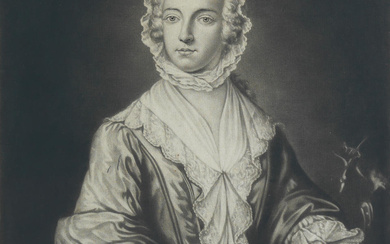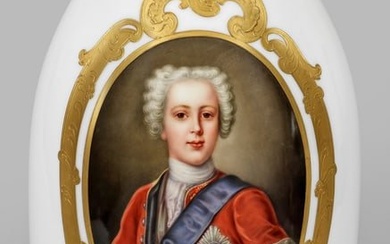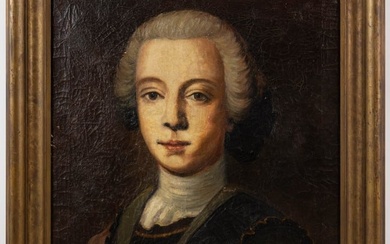THE PRINCE CHARLES EDWARD STUART WALKING CANE AN
THE PRINCE CHARLES EDWARD STUART WALKING CANE AN IMPORTANT 18TH CENTURY EUROPEAN DAMASCENE STEEL AND GOLD MOUNTED WALKING CANE unmarked, the gold inlaid steel head with compressed gold inlaid pommel, with British crown surmounting initials ‘CEÂ’ within arched and foliate borders, the lower panelled section of the head formed of finely inlaid foliate scrolls with inlaid ribbed and plain collars below, the tapered snake wood stick with inlaid gold eyelet and later brass ferule to point (Steel head 6.5cm long, pommel 3.3cm diameter, overall length 94.5cm) Provenance:By repute Prince Charles Edward Stuartand then gifted to a French Noble FamilyBy descent till circa 1905 - 1909Presented to Alfred William Cox (1857 – 1919)By direct descentExhibited: Stuart and Cromwell Relics, and articles of interest connected with the Stuart Period , Cambridge Antiquarian Society, Guildhall Cambridge 15th-20th May 1911, item 5 (lent anonymously) Note: Although many relics of the Jacobite Cause exist, few are directly and personally connected with the Stuart family, or a single member, so directly. This walking cane was no doubt an important and highly personal accessory of the fashionable Prince Charles Edward Stuart, used within the Courts of Europe when petitioning his cause. A history of portraiture illustrates the Prince as a young, fashionable, educated and confident man. With much of his life spent in Europe in the presence of many Royal courts, he was keen to portray an image of the upmost grandeur at all times. In the 18th century, it was de rigueur to own a fine walking cane; a reflection of oneÂ’s societal status, wealth and artistic interests. Sadly, no portraits can be found of the Prince which feature a walking cane, as these more often focus on official symbols of office and heraldry. However, in the Scottish National Portrait GalleryÂ’s collection, Paolo Monaldi & Pubalacci & SilvestriÂ’s exceptional painting, Prince James receiving his son, Prince Henry, in front of the Palazzo del Re , Prince CharlesÂ’ father James and his court can be seen with several walking canes, serving as a statement accessory; a clear indication of the fashionable taste amongst the StuartÂ’s social circles.It is remarkable to consider the cane’s long history with such few breaks in ownership. When it was exhibited in 1911, it was recorded as having been ‘used by Prince Charles when he was at the French court, and was presented by him to a French nobleman, in whose family it has remained until a few years ago, when it was presented by the present holder of the title to the lender’. For some time, the cane was considered to have been a gift to Prince Charles from King Louis, however it has not been possible to substantiate this. Despite this, the worked elements of the cane are certainly European, and draw comparisons to some of the finest gold inlaid and steel metalwork made in France and Germany. A closer look at the inlaid decoration is revealing: the placement of the British crown above his initials rather boldly indicates his rightful claim to the throne. Being the monarch's crown, it is possible that this cane was made for Charles after his father's death and he titled himself King Charles III. Indeed, other personal monogrammed items which survive feature the initials CP for Carlos Princepus . While there is some speculation as to whether the cane was gifted by King Louis, there is no doubt surrounding the quality of manufacture. Moreover, the gifting to a French noble family by Prince Charles successfully traces the provenance back to CharlesÂ’ own lifetime; a highly unusual feat and few comparisons exist outwith established museum collections. By the 1911 exhibition the cane was the property (although lent anonymously) of Alfred William Cox. Alfred was a remarkable character of Victorian society. Son of Alexander Robb Cox (1826-1880) he came from a long line of successful Scottish jute merchants and factory owners working in Dundee and Liverpool. In 1879, and on failing his entrance exams for the Military Academy at Woolwich, he was given £100 and an allowance to travel to Australia. His father's intention was for him to learn about the sheep trade and presumably set up his own. But before long he had fallen into his favourite leisure pursuit and was again involved in gambling on horse racing, which had perhaps originally led to his failed exams back in England. On hearing this, his father threatened to cut his allowance and seek his return. For a short time at least, Alfred went into sheep farming. This was not to last long however, his interests inevitably shifted over a game of cards in which he won a share in what became the Broken Hill silver mine, for a sum £120. He would return to England a wealthy man in the late 1880Â’s with his shares value then estimated at £1,260,000 (some £70m in todayÂ’s terms). On his return he became one of BritainÂ’s most successful race horse owners and had many renowned winners, perhaps most famous is Bayardo, a short career which is still remembered today. Late Victorian and Edwardian horse racing at the highest levels was a highly a social event. A fashionable cane such as this would have served Alfred well when in attendance at the Royal Enclosure, and especially when in the company of the Prince of Wales (later King Edward VII) who frequented there. Alfred Cox had a small but fine collection of canes, this no doubt the highlight. How it came into his collection when it was ‘presentedÂ’ to him by the Noble French family remains a mystery, but family tradition has often held that it may have been in lieu of a debt for a horse, stud fees, or likely gambling.
[ translate ]Sale price
Estimate
Time, Location
Auction House
THE PRINCE CHARLES EDWARD STUART WALKING CANE AN IMPORTANT 18TH CENTURY EUROPEAN DAMASCENE STEEL AND GOLD MOUNTED WALKING CANE unmarked, the gold inlaid steel head with compressed gold inlaid pommel, with British crown surmounting initials ‘CEÂ’ within arched and foliate borders, the lower panelled section of the head formed of finely inlaid foliate scrolls with inlaid ribbed and plain collars below, the tapered snake wood stick with inlaid gold eyelet and later brass ferule to point (Steel head 6.5cm long, pommel 3.3cm diameter, overall length 94.5cm) Provenance:By repute Prince Charles Edward Stuartand then gifted to a French Noble FamilyBy descent till circa 1905 - 1909Presented to Alfred William Cox (1857 – 1919)By direct descentExhibited: Stuart and Cromwell Relics, and articles of interest connected with the Stuart Period , Cambridge Antiquarian Society, Guildhall Cambridge 15th-20th May 1911, item 5 (lent anonymously) Note: Although many relics of the Jacobite Cause exist, few are directly and personally connected with the Stuart family, or a single member, so directly. This walking cane was no doubt an important and highly personal accessory of the fashionable Prince Charles Edward Stuart, used within the Courts of Europe when petitioning his cause. A history of portraiture illustrates the Prince as a young, fashionable, educated and confident man. With much of his life spent in Europe in the presence of many Royal courts, he was keen to portray an image of the upmost grandeur at all times. In the 18th century, it was de rigueur to own a fine walking cane; a reflection of oneÂ’s societal status, wealth and artistic interests. Sadly, no portraits can be found of the Prince which feature a walking cane, as these more often focus on official symbols of office and heraldry. However, in the Scottish National Portrait GalleryÂ’s collection, Paolo Monaldi & Pubalacci & SilvestriÂ’s exceptional painting, Prince James receiving his son, Prince Henry, in front of the Palazzo del Re , Prince CharlesÂ’ father James and his court can be seen with several walking canes, serving as a statement accessory; a clear indication of the fashionable taste amongst the StuartÂ’s social circles.It is remarkable to consider the cane’s long history with such few breaks in ownership. When it was exhibited in 1911, it was recorded as having been ‘used by Prince Charles when he was at the French court, and was presented by him to a French nobleman, in whose family it has remained until a few years ago, when it was presented by the present holder of the title to the lender’. For some time, the cane was considered to have been a gift to Prince Charles from King Louis, however it has not been possible to substantiate this. Despite this, the worked elements of the cane are certainly European, and draw comparisons to some of the finest gold inlaid and steel metalwork made in France and Germany. A closer look at the inlaid decoration is revealing: the placement of the British crown above his initials rather boldly indicates his rightful claim to the throne. Being the monarch's crown, it is possible that this cane was made for Charles after his father's death and he titled himself King Charles III. Indeed, other personal monogrammed items which survive feature the initials CP for Carlos Princepus . While there is some speculation as to whether the cane was gifted by King Louis, there is no doubt surrounding the quality of manufacture. Moreover, the gifting to a French noble family by Prince Charles successfully traces the provenance back to CharlesÂ’ own lifetime; a highly unusual feat and few comparisons exist outwith established museum collections. By the 1911 exhibition the cane was the property (although lent anonymously) of Alfred William Cox. Alfred was a remarkable character of Victorian society. Son of Alexander Robb Cox (1826-1880) he came from a long line of successful Scottish jute merchants and factory owners working in Dundee and Liverpool. In 1879, and on failing his entrance exams for the Military Academy at Woolwich, he was given £100 and an allowance to travel to Australia. His father's intention was for him to learn about the sheep trade and presumably set up his own. But before long he had fallen into his favourite leisure pursuit and was again involved in gambling on horse racing, which had perhaps originally led to his failed exams back in England. On hearing this, his father threatened to cut his allowance and seek his return. For a short time at least, Alfred went into sheep farming. This was not to last long however, his interests inevitably shifted over a game of cards in which he won a share in what became the Broken Hill silver mine, for a sum £120. He would return to England a wealthy man in the late 1880Â’s with his shares value then estimated at £1,260,000 (some £70m in todayÂ’s terms). On his return he became one of BritainÂ’s most successful race horse owners and had many renowned winners, perhaps most famous is Bayardo, a short career which is still remembered today. Late Victorian and Edwardian horse racing at the highest levels was a highly a social event. A fashionable cane such as this would have served Alfred well when in attendance at the Royal Enclosure, and especially when in the company of the Prince of Wales (later King Edward VII) who frequented there. Alfred Cox had a small but fine collection of canes, this no doubt the highlight. How it came into his collection when it was ‘presentedÂ’ to him by the Noble French family remains a mystery, but family tradition has often held that it may have been in lieu of a debt for a horse, stud fees, or likely gambling.
[ translate ]






